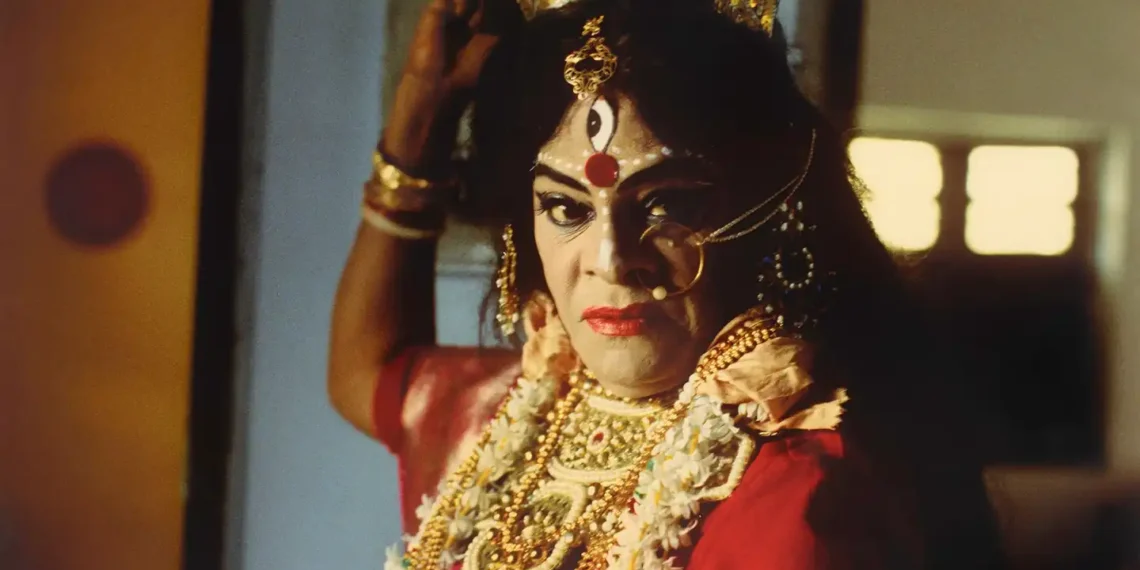The Last of Bengal’s Female Impersonators
A Life in Transformation
For Chapal Bhaduri, the last known female impersonator of Bengal’s folk theater, getting into character was both a ritual and a performance. Before stepping onto the stage, he would bring his hands together in prayer, meticulously applying makeup—drawing on eyebrows, affixing eyelashes, and slipping into a bra, blouse, wig, and golden jewelry.
The final touch of his transformation was the application of a symbolic “third eye” on his forehead, marking his metamorphosis into Shitala, the Hindu goddess of ailments, including smallpox. This powerful moment was immortalized in an iconic photograph by director and publisher Naveen Kishore, who later introduced Bhaduri’s story to the world through his acclaimed 1999 documentary, Performing the Goddess: The Chapal Bhaduri Story. In the striking image, Bhaduri raises a performative arm, staring past the camera with a defiant intensity.
“Until then, he is a man becoming a woman. With the third eye, he becomes the goddess,” Kishore explained in a video interview with CNN. “Then there’s no more banter, no humor, no cracking jokes or singing in a bad voice.”
A Star of Jatra Theater
Now retired and in his mid-80s, Bhaduri was once a celebrated figure in jatra, a vibrant traveling musical theater tradition performed in Bengali-speaking regions of India and Bangladesh. In the 1950s, when he first joined a jatra troupe, it was common for men to play female roles, as women were largely absent from the stage. Born into a family of actors, Bhaduri, performing under the stage name Chapal Rani, quickly rose to prominence in the Calcutta (now Kolkata) theater scene.
However, as more women entered jatra in the 1960s and 1970s, Bhaduri struggled to find work. By the time Kishore encountered him in the 1990s, Bhaduri was performing only a few times a year for as little as $1 a night. Moved by his plight, Kishore began documenting his life through photography, capturing the meticulous transformation process Bhaduri underwent before each performance. These black-and-white images were eventually exhibited and sold, with Kishore giving the proceeds to Bhaduri.
One day, the aging actor approached Kishore looking for work—offering to cook or even make coffee. “I was in tears at my own inability,” Kishore recalled. “I saw him as a star and thought, ‘Why would I give him a job in a kitchen?’”
From Stage to Screen
Determined to bring Bhaduri’s story to a wider audience, Kishore decided to create a documentary. Before filming, he arranged another photo shoot, this time in color, at Bhaduri’s home. Taking a discreet approach, Kishore aimed to capture his subject naturally.
“My entire practice is a shy one; I often lose a lot of good photographs because I feel I might be intruding,” he explained. “The shoot itself was just him and me… there was conversation throughout.”
Bhaduri, speaking from his care home in Kolkata, recalled the relaxed atmosphere:
“Naveen told me to forget that he was taking my pictures. He said, ‘Erase me from your mind. You just do your thing like you always do. Don’t look at the camera.’”
The resulting images—several of which are now displayed at the Smithsonian’s National Museum of Asian Art in the exhibition Body Transformed: Contemporary South Asian Photographs and Prints—offer an intimate glimpse into Bhaduri’s craft. In them, his metamorphosis unfolds through mirror reflections, bright red lipstick, and the application of a crimson tilaka on his forehead.
An Act of Vulnerability
These rituals became the foundation of Performing the Goddess, Kishore’s 44-minute documentary, in which Bhaduri animatedly recounts his life and career. The film interweaves interviews, personal monologues, and reflections on his experiences in theater—from almost being kidnapped by men who mistook him for a woman to studying the mannerisms of brothel madams in Kolkata’s red-light district to perfect his performances.
Initially planned as a brief production, the documentary took six weeks to complete. Kishore’s patience paid off when, just before editing began, Bhaduri made an unexpected revelation. He spoke candidly about his three-decade-long relationship with a married man—a bold admission in conservative 1990s India.
The scene, raw and deeply personal, became one of the film’s defining moments. “It was seen as an act of extreme vulnerability but also courage,” Kishore said. “The fact that he could speak about it—and do so without sensationalism—made the documentary even more powerful.”
A Lasting Legacy
Since its release, Performing the Goddess has been screened at film festivals, aired on Indian television, and exhibited in museums. The accompanying photographs have been displayed globally, sold at a Sotheby’s auction in 2007, and acquired by the Cincinnati Art Museum.
This exposure led to what Kishore described as a “strange resurrection” of Bhaduri’s career. Reflecting on his late-life recognition, Bhaduri expressed gratitude for the opportunity to share his art with new audiences, both in India and abroad.
“People said, ‘You have taken the story of Goddess Shitala, which usually takes place in fields and street corners, to such unimaginable heights,’” he recalled. “That was my ultimate reward.”
Though his performances have faded into history, Bhaduri’s legacy endures—not just as the last of Bengal’s female impersonators but as a testament to the power of resilience, artistry, and transformation.
This article was rewritten by JournosNews.com based on verified reporting from trusted sources. The content has been independently reviewed, fact-checked, and edited for accuracy, neutrality, tone, and global readability in accordance with Google News and AdSense standards.
All opinions, quotes, or statements from contributors, experts, or sourced organizations do not necessarily reflect the views of JournosNews.com. JournosNews.com maintains full editorial independence from any external funders, sponsors, or organizations.
Stay informed with JournosNews.com — your trusted source for verified global reporting and in-depth analysis. Follow us on Google News, BlueSky, and X for real-time updates.














